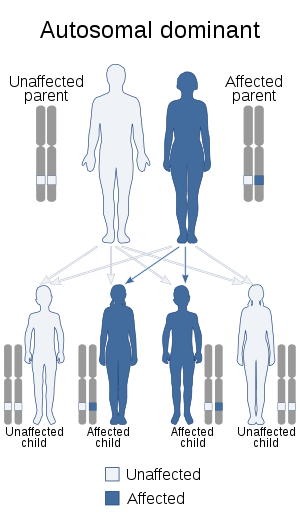Muckle–Wells syndrome
Muckle–Wells syndrome (MWS), is a rare autosomal dominant disease which causes sensorineural deafness and recurrent hives, and can lead to amyloidosis. Individuals with MWS often have episodic fever, chills, and joint pain. As a result, MWS is considered a type of periodic fever syndrome. MWS is caused by a defect in the CIAS1 gene which creates the protein cryopyrin. MWS is closely related to two other syndromes, familial cold urticaria and neonatal onset multisystem inflammatory disease—in fact, all three are related to mutations in the same gene and subsumed under the term cryopyrin-associated periodic syndromes (CAPS).
| Muckle–Wells syndrome | |
|---|---|
| Other names | Urticaria-deafness-amyloidosis syndrome (UDA),[1] |
 | |
| This condition is inherited in an autosomal dominant manner | |
| Specialty | Dermatology |
Sign and symptoms
- Sensorineural deafness
- Recurrent urticaria (hives)
- Fevers
- Chills
- Arthralgia (painful joints)
Causes
MWS occurs when a mutation in the CIAS1 gene, encoding for NLRP3, leads to increased activity of the protein cryopyrin. This protein is partly responsible for the body's response to damage or infection. During these states, a cytokine called interleukin 1β is produced by an innate immune cell known as a macrophage. This cytokine interacts with a receptor on the surface of other immune cells to produce symptoms of inflammation such as fever, arthritis, and malaise. In MWS, the increased activity of cryopyrin leads to an increase in interleukin 1β. This leads to inflammation all throughout the body with the associated symptoms.[2]
Diagnosis
Treatment
- Treatment with anakinra, an interleukin 1 receptor antagonist, can lead to an improvement in the hearing loss.[3]
- Rilonacept (Arcalyst) a dimeric fusion protein for the treatment of CAPS.
- Canakinumab, a monoclonal antibody against interleukin-1β
Prognosis
The chronic inflammation present in MWS over time can lead to sensorineural hearing loss. In addition, the prolonged inflammation can lead to deposition of proteins in the kidney, a condition known as amyloidosis.
History
MWS was first described in 1962 by Thomas James Muckle (1938-2014)[4] and Michael Vernon Wells (born 1932).[5]
Society and culture
The CBC Radio One program, White Coat, Black Art, hosted by Dr. Brian Goldman, presents a real-life study of the self-diagnosis by and successful treatment of a father and daughter with Muckle–Wells syndrome: 24 September 2016 episode
In the episode of popular TV series House, the main patient of the Season 7 episode Recession Proof is ultimately diagnosed with this condition.In an episode of TV series Cake Boss, Buddy Valastro works with a girl with this condition through Make-A-Wish Foundation.
See also
- Familial cold urticaria, a similar disease
- List of cutaneous conditions
- NOMID, a similar disease
- Urticarial syndromes
- CINCA Syndrome
References
- ORPHANET - About rare diseases - About orphan drugs
- Mariathasan S, Weiss DS, Newton K, McBride J, O'Rourke K, Roose-Girma M, Lee WP, Weinrauch Y, et al. (March 2006). "Cryopyrin activates the inflammasome in response to toxins and ATP". Nature. 440 (7081): 228–32. Bibcode:2006Natur.440..228M. doi:10.1038/nature04515. PMID 16407890.
- Rynne M, MacLean C, Bybee A, McDermott MF, Emery P (April 2006). "Hearing improvement in a patient with variant Muckle‐Wells syndrome in response to interleukin 1 receptor antagonism". Annals of the Rheumatic Diseases. 65 (4): 533–4. doi:10.1136/ard.2005.038091. PMC 1798106. PMID 16531551.
- Churchill, Dave. "Former McMaster professor had taste for adventure and great wine". Hamilton Spectator.
- Muckle TJ (April 1962). "Urticaria, deafness, and amyloidosis: a new heredo-familial syndrome". The Quarterly Journal of Medicine. 31: 235–48. PMID 14476827.
External links
| Classification | |
|---|---|
| External resources |